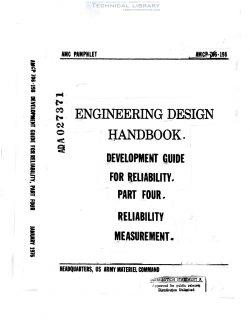AMCP-786-198
- Version
- 344 Downloads
- 10.10 MB File Size
- 1 File Count
- March 5, 2017 Create Date
- March 5, 2017 Last Updated
Engineering Design Handbook - Development Guide for Reliability - Part IV; Reliability Measurement

1-1 GENERAL Reliability measurement techniques provide a common discipline that can be used to make system reliability projections through- out the life cycle of a system. The data on component and equipment failures obtained during the reliability measurement program can be used to compute component failure distributions and equipment reliability char- acteristics. Reliability measurement tech- niques are used during the research and development phase to measure the reliability of components and equipments and to eval- uate the relationships between applied stresses and environments and reliability. Later in a system life cycle, reliability measurement and testing procedures can be used to demonstrate that contractually required reliability levels have been met. Uniform criteria for establishing a reliabil- ity measurement program are defined in MIL-STD-785 (Ref. l). These standards must be incorporated into Department of Defense procurements of all systems that undergo contract definition. If a system does not re- quire a contract definition effort, they can be incorporated in the request for proposal (RFP). The Army has developed a number of reg- ulations, complementing MIL-STD-785, which establish reliability as a major parameter which must be measured during the develop- ment Of a new weapon system (Refs. 2, 3, and 4). All Army materiel ought to be phys- ically tested to determine whether the design requirunents, including reliability, have been met. Testing is performed under the direction
of the appropriate AMC commodity com- mands, project managers, and installations or activities which report directly to Head- quarters AMC. The US Army Test and Evaluation Com- mand (USATECOM) is responsible for review- ing test documentation produced by other Army organizations. USATECOM can, at its own discretion, conduct independent tests and evaluations on any Army developed sys- tem (Ref. 5). The reliability measurement techniques described in this volume are con- sistent with Army Regulations and can be applied directly 10 systems developed under Arlny auspices. A reliability measurement system consists Of two major functional divisions: (l) the test program, and (2) the data system.
| File | Action |
|---|---|
| AMCP-786-198 Engineering Design Handbook - Development Guide for Reliability - Part IV; Reliability Measurement.pdf | Download |

Comment On This Post